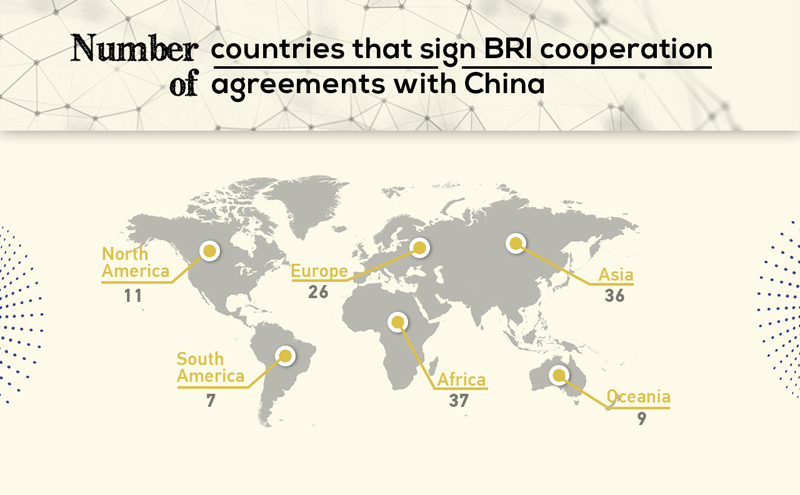Belt and Road Initiative
The Belt and Road Initiative is a global development strategy adopted by the Chinese government in 2013 involving infrastructure development and investments in Asia, Europe, and Africa. The strategy is made to connect Asia with Africa and Europe via land and maritime networks along six corridors with the aim of improving regional integration, increasing trade and stimulating economic growth.
The name was coined in 2013 by President Xi, who drew inspiration from the concept of the Silk Road established during the Han Dynasty 2,000 years ago – an ancient network of trade routes that connected China to the Mediterranean via Eurasia for centuries. The BRI has also been referred to in the past as 'One Belt One Road'.
"Belt" refers to the "the Silk Road Economic Belt"; whereas "road" refers to the "21st Century Maritime Silk Road".

Silk Road Economic Belt
President Xi visited Astana, Kazakhstan, and Southeast Asia in September and October 2013, and proposed jointly building a new economic area, the Silk Road Economic Belt (Chinese: 丝绸之路经济带). Essentially, the "belt" includes countries situated on the original Silk Road through Central Asia, West Asia, the Middle East, and Europe.
Three belts are proposed. The North belt would go through Central Asia and Russia to Europe. The Central belt passes through Central Asia and West Asia to the Persian Gulf and the Mediterranean. The South belt runs from China to Southeast Asia, South Asia, to the Indian Ocean through Pakistan. Many of the countries that are part of this belt are also members of the China-led Asian Infrastructure Investment Bank (AIIB).
21st Century Maritime Silk Road
The "21st Century Maritime Silk Road" (Chinese: 21世纪海上丝绸之路), or just the Maritime Silk Road, is the sea route 'corridor'. It is a complementary initiative aimed at investing and fostering collaboration in Southeast Asia, Oceania, and Africa, through several contiguous bodies of water: the South China Sea, the South Pacific Ocean, and the wider Indian Ocean area. It was first proposed in October 2013 by President Xi in a speech to the Indonesian Parliament.
Two Maritime Silk Roads are proposed. One road would sail from China’s coastal cities through the South China Sea and the Indian Ocean to Europe. The other road would also ship from China’s coastal cities through the South China Sea but to South Pacific countries. Like the Silk Road Economic Belt initiative, most countries have joined the AIIB.
Major Priorities
The initiative defines five major priorities:
Policy coordination;
Infrastructure connectivity;
Unimpeded trade;
Financial integration;
Connecting people.
Main Achievements
China has signed co-operational documents on the belt and road initiative with 126 countries and 29 international organizations. In terms of infrastructure construction, China and the countries along the Belt and Road have carried out effective cooperation in ports, railways, highways, power stations, aviation and telecommunications. The program is expected to involve over US$1 trillion in investments. The BRI’s geographical scope is constantly expanding. So far it covers over 70 countries, accounting for about 65 per cent of the world’s population and around one-third of the world’s Gross Domestic Product (GDP).
Benefits to the International Students
As the Belt and Road Initiative continues to bring tangible benefits to the countries involved, more students from the Belt and Road route countries are choosing to study in China, and many of them are starting to learn business and technology in addition to language and culture in Chinese universities.
Instead of simply choosing language studies, more international students are choosing to study science and business or other practical majors in China. And Chinese universities, especially those located in China’s coastal cities, have launched cooperative programs on talent training to help with local development.
The cooperation programs for training talents would also help to develop bilateral ties between China and countries along the Belt and Road route. More and more jobs will be developed by the projects initiated by BRI. With the advantage of experience in China, the international students graduated in Chinese universities are good candidates for those new jobs.
Related Reading
Assistant Export Specialist Internship
